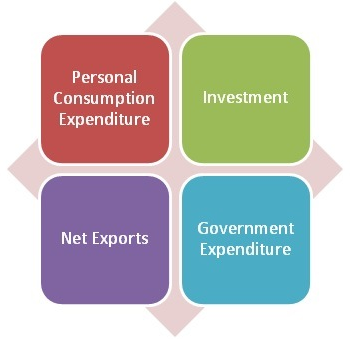Yesterday the Wall Street Journal told us this expansion is the weakest in over 60 years. Hmmm…. Maybe it really IS that bad!
Why You Should Care: Alternative opinions are meaningful. They force us to test and question our own beliefs.
Taking Action: Again, it’s important to be informed – especially in the middle of Election Season. We’re in the last 100 days…and both machines are swinging into action. Rest assured, GDP growth – or lack thereof – will be a hot topic on the campaign trail and in the debates. Get informed.
The Blog: Per the article, 2016 economic growth for the first 1/2 of the year is at a 1.0% run rate. And since the end of the recession, we’ve seen only a 2.1% annual GDP growth rate – the weakest expansion pace since 1949:
Remember, Obama took office in 2009. I have no doubt the Trump campaign will ‘trumpet’ this apparent correlation (see that? Trump…trumpet? 🙂 )
I’m sure you recall the four GDP components:
How did each contribute to the total this quarter? Well, PCE was the star. The other segments, not so much. In the quarter, here’s what each added to the GDP:
- Personal Consumption Expenditures (PCE) + $190 billion
- Investment – ($64) billion
- Net Exports +17 billion
- Government Expenditure + $12 billion
So, while Exports and Government spending made a small contribution, Investment was a huge drag and PCE pretty much carried the ball, so to speak. Clearly, weak ‘Investment’ is a problem. But what, specifically, is ‘Investment?’
The full name of this category is “Gross Private Domestic Investment“:
Gross private domestic investment (“GPDI”) is the measure of physical investment used in computing GDP in the measurement of nations’ economic activity. This is an important component of GDP because it provides an indicator of the future productive capacity of the economy.
Interesting. Said another way, it appears GPDI is the investment, by individuals and companies, in assets that potentially increase future economic production.
Let’s break this down a bit further. GPDI is the sum of 2 items: ‘Fixed Investment‘ and ‘Change in private inventories.’ Fixed investment is also the sum of two items: investment in ‘residential structures‘ and in ‘non-residential‘ assets. For the quarter every single component of GPDI was negative, with the sole exception of a small $1.6 billion increase in inventories.
More concerning, since 2015: Q3, GPDI has been declining at a fairly steady clip. After growing consistently since the beginning of this expansion in 2009, since October of 2015 it’s down about 4%. Investment in future productivity, for some reason, is slowing.
Alternatively, consumer spending continues to rise. Take a look at the one-year chart below…where you’ll see trending of both the PCE (left side of the chart) and the GPDI (right side):
It’s entirely possible this is not a trend. It is likely to bounce back in Q3. Why? Strong consumer spending (PCE) depletes inventories, which, of course, are the source of the ‘stuff’ consumers buy. According the the BEA, “Inventories are maintained by business in order to facilitate the production and distribution of goods or services.”
Further, residential investment was also negative this quarter. After 2 years of consistent growth. I suspect this is also temporary and will turn around next quarter. Sure, the US multi-family construction boom is waning…but I think we’ll see more strength here next quarter.
I can’t really comment intelligently on the decline in the other GPDI components. It’s possible we’re seeing a slow-down here due to another persistent, nagging issue – declining productivity. Maybe. All we can do is continue to track these trends.
As is said in my last blog, it’s really not that bad. Nor is it good. It’s just, well, so-so.
Yes, when measured against economic expansions of the past, this one looks anemic. And now at over 8 years, is becoming one of the longest. Might anemic and long equal slow and steady?
That’s the way it appears to me.
- Terry Liebman




Hi Terry, I wanted to let you know that I have begun to follow your blog and very much enjoy your insights.
Regards, David
LikeLike
Thanks David! Much appreciated!
LikeLike